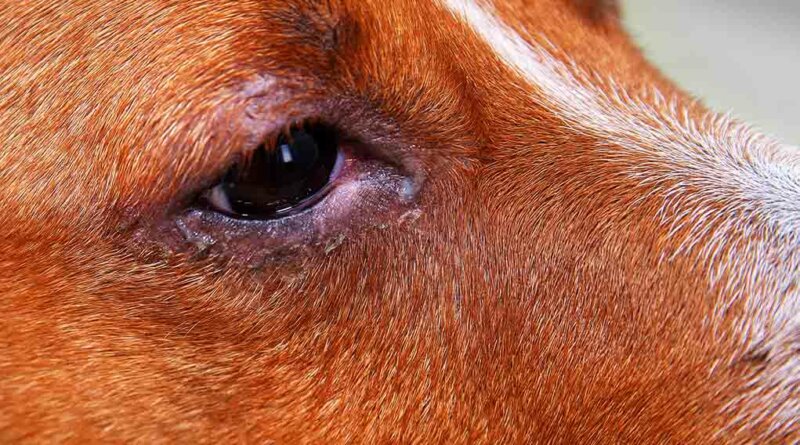Natural Remedies for Pink Eye in Dogs
For many dog owners, having to face eye problems can be expensive and problematic. Many dogs suffering from eye problems can be rather obvious, with most showing physical signs when faced with issues. Many pups with injured eyes will wink excessively, hold the eye closed, rub their faces against the ground, and rub at their eyes. It’s not uncommon for some dogs to also use their paw to try and wipe the area. This article is all about the natural remedies for pink eye in dogs.
Understanding Conjunctivitis in Dogs
Although the technical name is conjunctivitis, this condition is more commonly referred to as pink eye. This normally occurs in the pink part around the eye. This area is called the conjunctiva and will become inflamed when the dog is suffering from the condition. Identifying conjunctivitis in dogs isn’t as straightforward as in humans, in part because their eyelids cover the whites of their eyes. For some dogs, the first identifiable symptom is swelling that causes the third eyelid to show.
Occasionally, discharge can occur from the eye, ranging from puss, mucus, or clear color. Chances are, if a discharge is occurring, there is an infection in the eye. If both eyes have clear discharge, it’s more likely to be a viral issue. Bacterial infections are normally present when a pussy discharge is noted around the eye. There are both medications and natural remedies for pink eye.
Causes of Pink Eye
Pink eye can stem from another eye issue or problem, or it can begin independently due to bacterial infections, viral infections, or even allergies. Allergens can include dust, pollen, or chemical compounds, like cigarette smoke or even dog shampoo. Conjunctivitis can occur in both eyes or an individual eye, depending on the cause. If only one eye has pink eye symptoms, chances are it has not yet spread to both eyes, or a foreign body in the eye like grass see, grit, particles, or an injury has occurred.
Injuries to the eye can also cause symptoms of conjunctivitis. If these injuries occur, they may include a scrape, bite, blow, or puncture (for example, a thorn). Blocked or infected tear ducts can stem from irritation around the hair of the eye, an abnormal growth, or a minor injury near the eye causing an abscess. Before using natural remedies for pink eye, it’s important to determine the cause.
Although there are some instances where treating conjunctivitis at home is appropriate and necessary, there are many instances that medication from a veterinarian is required to clear the issue, particularly in bacterial infections. These medications can include antihistamines, anti-inflammatories, antibiotics, and steroids.
When using natural remedies for pink eye, always pay attention to the signs and symptoms. If your dog is continuing to get worse or appears to be in pain, bring them to a veterinarian for an evaluation.
Here are a few natural remedies for pink eye to help your dog
Saline Drops
If you believe your dog has an irritant in his eye, use saline eye drops to flush them out safely. These natural remedies for the pink eye are not painful for the dog and can quickly remove anything in the eye. Although these drops will not get rid of an eye infection (this often needs prescription medication), they can offer relief to the area temporarily.
When purchasing, look for saline eye drops online, at a local pharmacy, or within a pet store. You’ll want to squirt the product into the dog’s eyes carefully and gently. It’s important to note that saline eye drops are not the same as contact lens solutions for humans. Contact lens solution often has added ingredients into the mixture and should never be administered to dogs.
Administering anything to the eye can be exceptionally difficult, especially if the area is already inflamed and painful. It’s important to work gently around the area, always using soft handling around the dog’s face. Using your non-dominant hand, gently wrap your hand around the front of the dog’s chest, holding him tightly against your chest. Use the same hand to hold his snout upward toward your face. Holding the saline drops in between your thumb and index finger, carefully pull down the lower eyelid. Gently squirt the solution into the eye and let go of your grasp.
How to Make Your Own Saltwater Rinse for Your Dog
Boil a water cup until it is rapidly boiling (alternatively, you can use mineral water for this purpose). Add half a teaspoon of salt to the boiled water and allow it to cool. Use a cotton wool ball to clean any discharge from the eye with this rinse once or twice a day.
Alternative Method for Soothing Irritated Eyes
This natural remedy for pink eye is not meant for direct application to the eye, only use around the eye area. Chamomile tea is believed to hold antibacterial properties and offers a soothing mixture for irritated, sore eyes. Steep the teabag in a cup of boiling water and allow it to cool. Do not throw away the bag of tea! Once room temperature, use the tea bag to apply the tea around the eye area. Likewise, you can use cotton wool balls dipped in the tea as an alternative.
Use these applications daily, as needed. Always ask the veterinarian if continuing the rinse or tea application is recommended with antibiotics or antivirals. Some medications may recommend not wiping the area to prevent dispersing the medication outside the eye area.
Using an E-Collar or Protective Cone for the Dog
It’s important to note that the e-collar and protective cone are not direct natural remedies for pink eye. They will, however, prevent further damage from occurring, caused by rubbing the face against the ground or using the paw to scratch the area. The e-collar is designed to prevent scratching or causing trauma while in use.
By having the plastic barrier, the dog can still attempt to scratch or rub but won’t contact the injured eye. When sizing a cone for your dog, look for a cone that extends two inches beyond your dog’s nose. Never leave your dog unattended while wearing the cone, as it can become stuck or entangled on objects. Always take the cone off before bedtime.
To attach the collar, use some gauze or high-quality ribbon to thread the cone hoops. Wrap the gauze around the collar material.
Artificial Tears for Dogs
Although they seem similar to saline drops, artificial tears contain a safe lubricant that can help bring much-needed moisture to the eye. If your dog has dry and irritated eyes, the moisture can lower inflammation. They are natural remedies for pink eye because they don’t contain any antibiotics or medicinal compounds, so they won’t eliminate a bacterial infection while adding moisture.
You can find artificial tears as either an ointment or an eye drop. A common use is for dogs diagnosed with dry eyes. To help relieve pink eye in dogs, they are designed to continuously lubricate the eye (instead of flushing everything out). Only small amounts of the products are needed, making it a long-lasting product.
Cold Compresses and Ice
Cold compresses work to remove or eliminate swelling and inflammation, including that caused by pink eye. A cold, wet compress or washcloth is normally the easiest and most comfortable remedy. Always opt for soft cold compresses or washcloths over hard ice blocks. It will be easier to apply and less likely to irritate the area. If needed, the soft, cold compress can be purchased both online and from pharmacies.
Simply apply the compress to a closed eye, several times a day, for several minutes at a time. The compress will help lower any swelling and inflammation but will not treat any infection of the eye.
Is Conjunctivitis Contagious to Dogs or Humans?
Depending on the cause of infection, some secretions can be considered contagious. Contact with the eye’s secretions increased the probability of viruses and parasites spreading infection between dogs, especially unneutered ones.
Some parasitic infections like leishmaniasis and toxocariasis can absolutely spread conjunctivitis to humans as well as other dogs. It’s imperative to limit the spread of bacteria and parasites using common hygienic measures. This includes only using clean supplies when treating your dog, avoiding shared medications between dogs, despite symptoms, washing hands after treating the animal, limiting contact with the weeping eye (for example, avoiding affection to the face directly until the infection clears), and ensuring clean bedding and living areas.
 When to Seek Medical Treatment for Your Dog
When to Seek Medical Treatment for Your Dog
If your dog has a history of allergies that cause redness, itchiness, inflammation, or swelling, you may be okay to treat the symptoms at home for a day or so to see if they improve. For any eye injury, it’s crucial to seek medical treatment immediately – many vets can reverse injuries. Prompt attention is given.
It’s always a wise idea to have a veterinarian look over your dog if you’re unsure of the cause of the pink eye. This is especially true when it comes to itching or pawing at the eyes, as it can further damage and traumatize the area (making things worse instead of better).
During your vet appointment, the vet will ask some general health questions, as well as a brief history leading up to the eye issues. He may ask for potential locations you and your dog have visited, including nearby parks, facilities, or dog enclosures (leash-free parks). The main objective is to determine the pink eye’s cause, whether that is an injury or an infection.
After taking the history, the veterinarian will perform a physical examination to assess the cause of the inflammation and irritation further. This might include examining the eye itself, around the eye, and an overall wellness check (including temperature and evaluating your dog’s overall health). For extensive eye issues, a referral to a canine eye specialist may be required.
Treatment for Dog Conjunctivitis
Treatment for your dog’s pink eye will depend on the root cause. If there is an irritant or foreign body, removal will be necessary. Depending on the irritant, it may need to be removed from the home to happen again. For example, if your dog is reacting to a specific plant you have within your home, removal will be necessary to prevent reoccurrence. If the natural remedies for pink eye don’t work, flushing the eye by your vet may be necessary, depending on the foreign body.
Should a parasite, bacteria, or virus be causing the dog’s symptoms, the vet will prescribe an appropriate antiviral or antibiotic medication. Depending on the circumstance, there’s also a probability of pain reducers being prescribed, depending on the issue or injury.
Recovery of Conjunctivitis in Dogs
Once you know the cause of the irritation, it’s important to follow the recovery directions carefully. In some instances, this may mean inserting drops into the eye for months at a time. Always make sure the eye is clean before applying any medication. Use a clean washcloth to remove any discharge away from the eye.
How to Prevent Pink Eye in Dogs
One of the easiest steps you can take to limit conjunctivitis is sticking to all routine vaccinations. Serious viral infections can spread without immunizations, making it a safe-guard for your dog when in contact with other animals. You can also keep any fur or hair around your dog’s eyes trimmed and out of the eye area. This is particularly true if your dog has long hair. Try to learn if the eye irritation is caused by hair or debris. You will sometimes see foreign bodies attached to your dog’s fur around the eyes.
Should your dog regularly suffer from allergies or dry eyes, it’s important to maintain any regularly scheduled medications or appointments. Always give treatments as prescribed and for the duration required to clear the infection. Regularly inspecting the dog’s face is an important step in monitoring any problems or issues.
Final Thoughts
Pink eye, most of the time, is not serious. You can quickly clear with the right treatment. It’s important to have any eye issues evaluated by a veterinarian quickly, especially if it involves an injury or foreign body. If you do not resolve the initial issue, permanent damage can result. Make time and effort to understand the cause when your dog is suffering. When in doubt, give your dog’s vet a call and ask them for guidance on how to handle the symptoms.
Read Next: My Dog Has Red Eyes: Here’s Why and What to Do










